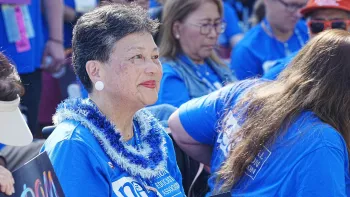Aspiring Teacher
Collaborate in the design, implementation, evaluation, and improvement of TPPs. Use recommendations from NEA’s 2014 “Teacher Residencies” as a guide for design. Include elements such as:
-
Ensure candidates explore the range of experiences within PreK-12 classrooms and beyond to be “profession ready” upon program completion.
-
Ensure cooperating teachers have the teaching skills and abilities to positively foster professional growth for the aspiring teachers with whom they work.
-
Provide ongoing training for cooperating teachers, give them feedback on their work in those roles, and gather feedback from them about programs.
-
Collaboratively and purposefully pair candidates with cooperating teachers.
-
Integrate cooperating teachers as faculty within the TPP.
-
Provide compensation for additional expertise and responsibilities of serving as cooperating teacher.
-
Use professional/accomplished PreK-12 teachers more broadly in TPP roles in schools and on campus.
-
Ensure that TPP faculty also have recent, relevant PreK-12 experience.
-
Focus programs on preparing candidates to meet the needs of every student through culturally responsive practice and sensitivity to student differences including race, ethnicity, gender, sexual orientation/gender identification, disability, religious beliefs, residence, and primary language.
Recommended collaborators: NEA and Affiliates, Schools/Districts
Partner with PreK-12 schools to provide academic support to promising candidates needing assistance. Programs must model culturally responsive teaching and best practices in authentic learning environments. Recommended collaborators: NEA and Affiliates, Schools/Districts
Develop and implement extensive experiences for candidates to work with parents, families, and in the community within the school and beyond. Recommended collaborators: NEA and Affiliates, Schools/Districts, External Partners/Community
Ensure candidates develop the knowledge, skills, and dispositions to meaningfully engage parents in the teaching/learning process and to develop learning experiences that are culturally responsive to, and honor the background of, each student. Recommended collaborators: NEA and Affiliates, Schools/Districts, External Partners/Community
Collaboratively develop and implement experiences to help aspiring teachers build positive connections with the communities where they work, and for schools, unions, and communities to provide support for the psychological, cultural, and emotional needs of the aspiring teacher. Recommended collaborators: Teachers, NEA and Affiliates, Schools/Districts, External Partners/Community, Policymakers
Create a network of preparation programs, with schools and districts sharing successful TPP practices and fostering collaboration across all partners. Recommended collaborators: NEA and Affiliates, Schools/Districts, External Partners/Community, Policymakers
Ensure design of programs aligns with national standards for program design and “profession readiness” of candidates.
Systemically show value of work with candidates and PreK-12 schools (promotion, tenure, etc.).



